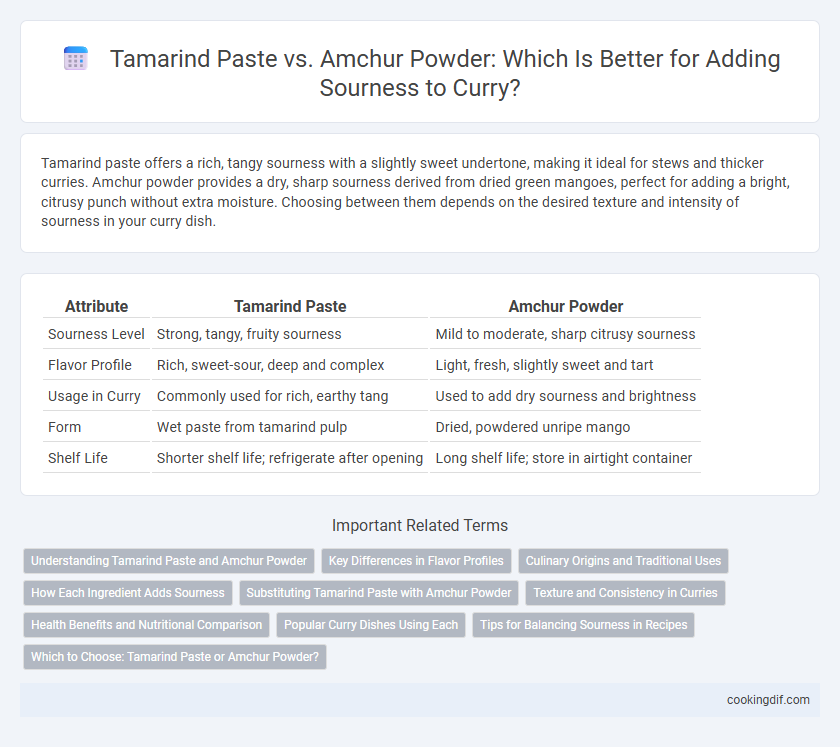Tamarind paste offers a rich, tangy sourness with a slightly sweet undertone, making it ideal for stews and thicker curries. Amchur powder provides a dry, sharp sourness derived from dried green mangoes, perfect for adding a bright, citrusy punch without extra moisture. Choosing between them depends on the desired texture and intensity of sourness in your curry dish.
Table of Comparison
| Attribute | Tamarind Paste | Amchur Powder |
|---|---|---|
| Sourness Level | Strong, tangy, fruity sourness | Mild to moderate, sharp citrusy sourness |
| Flavor Profile | Rich, sweet-sour, deep and complex | Light, fresh, slightly sweet and tart |
| Usage in Curry | Commonly used for rich, earthy tang | Used to add dry sourness and brightness |
| Form | Wet paste from tamarind pulp | Dried, powdered unripe mango |
| Shelf Life | Shorter shelf life; refrigerate after opening | Long shelf life; store in airtight container |
Understanding Tamarind Paste and Amchur Powder
Tamarind paste, extracted from tamarind fruit pulp, offers a rich, tangy sourness with subtle fruity undertones ideal for deep, complex curry flavors. Amchur powder, derived from dried green mangoes, provides a sharp, citrusy acidity with a lighter, more vibrant sourness often used to brighten lighter dishes. Both ingredients enhance sourness but differ in texture and intensity; tamarind paste adds moisture and depth, while amchur powder delivers a dry, zesty tartness suitable for seasoning.
Key Differences in Flavor Profiles
Tamarind paste delivers a rich, tangy sourness with fruity and slightly sweet undertones, making it ideal for complex curry sauces. Amchur powder, derived from dried green mangoes, offers a sharper, crisp acidic flavor with subtle fruity notes, contributing a fresher, more citrusy tartness. The choice between them hinges on whether a deep, mellow sourness (tamarind) or a bright, zesty tang (amchur) better complements the curry's overall flavor profile.
Culinary Origins and Traditional Uses
Tamarind paste, derived from the tamarind fruit native to Africa and widely used in Indian, Thai, and Mexican cuisines, provides a deep, fruity sourness ideal for rich curries and marinades. Amchur powder, made by drying and grinding raw mangoes, is a staple souring agent in North Indian cooking, valued for its sharp, tangy citrus flavor that brightens lentil dishes and vegetable curries. Both ingredients hold distinct traditional roles: tamarind paste imparts complexity and sweetness, whereas amchur powder lends a fresh, zesty acidity essential to many regional curry recipes.
How Each Ingredient Adds Sourness
Tamarind paste imparts a rich, deep, and slightly sweet sourness to curry, derived from its natural tart pulp, enhancing complex flavor profiles. Amchur powder offers a bright, sharp, and fruity tanginess, made from dried green mangoes, which provides a lighter and more aromatic sourness. The choice between tamarind paste and amchur powder depends on the desired intensity and type of sourness in the dish.
Substituting Tamarind Paste with Amchur Powder
Tamarind paste and amchur powder both provide sourness in curry, but amchur powder is a dried mango powder with a milder, fruity tang compared to the deep, complex sourness of tamarind paste. When substituting tamarind paste with amchur powder, use less amchur powder to avoid overpowering the dish, typically starting with half the amount and adjusting to taste. Amchur powder dissolves differently, so it's best added during the cooking process to blend smoothly into the curry's sauce.
Texture and Consistency in Curries
Tamarind paste provides a smooth, thick consistency that blends seamlessly into curries, creating a rich and uniform texture with a deep, tangy sourness. Amchur powder, being a dry spice, offers a more subtle and slightly grainy texture that disperses quickly, delivering a sharp, fresh citrus-like sourness without altering the curry's overall viscosity. Choosing tamarind paste enhances body and creaminess, while amchur powder maintains a lighter texture, allowing more control over the curry's final thickness.
Health Benefits and Nutritional Comparison
Tamarind paste provides a rich source of antioxidants, vitamins C and B, and dietary fiber, supporting digestion and immune health, while its natural tartness enhances curry flavors. Amchur powder, made from dried green mangoes, offers a concentrated dose of vitamin C and promotes digestive health with lower calories and sugars compared to tamarind paste. Both ingredients contribute to sourness in curries, but tamarind paste offers more comprehensive nutritional benefits, whereas amchur powder serves as a lighter, vitamin-rich alternative.
Popular Curry Dishes Using Each
Tamarind paste delivers a deep, fruity sourness essential in dishes like South Indian sambar and Thai massaman curry, enhancing complex flavor layers with its rich acidity. Amchur powder, derived from dried mangoes, imparts a bright, sharp tang commonly found in North Indian curries such as chana masala and aloo gobi, providing a subtle yet distinct citrusy sourness. Both ingredients play key roles in balancing spices and enhancing the overall taste profile of their respective regional curry recipes.
Tips for Balancing Sourness in Recipes
Tamarind paste delivers a rich, fruity sourness ideal for slow-cooked curries, while amchur powder offers a sharp, dry tang suited for lighter dishes or finishing touches. To balance sourness, start with small amounts and adjust gradually, tasting frequently to avoid overpowering other flavors. Combining tamarind paste with a pinch of sugar or using amchur powder alongside fresh lime juice can create a harmonious, layered acidity in curry recipes.
Which to Choose: Tamarind Paste or Amchur Powder?
Tamarind paste offers a rich, tangy sourness with a slightly sweet undertone, ideal for curries requiring a deep, complex flavor profile. Amchur powder, derived from dried green mangoes, provides a sharp, citrusy acidity and a dry texture that enhances freshness without added moisture. Choose tamarind paste for a moist, intense sourness and amchur powder when a dry, bright tartness is preferred in your curry.
Tamarind Paste vs Amchur Powder for sourness Infographic

 cookingdif.com
cookingdif.com